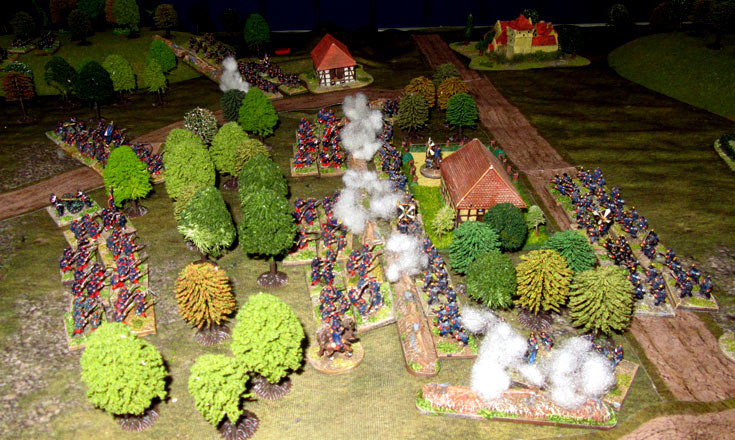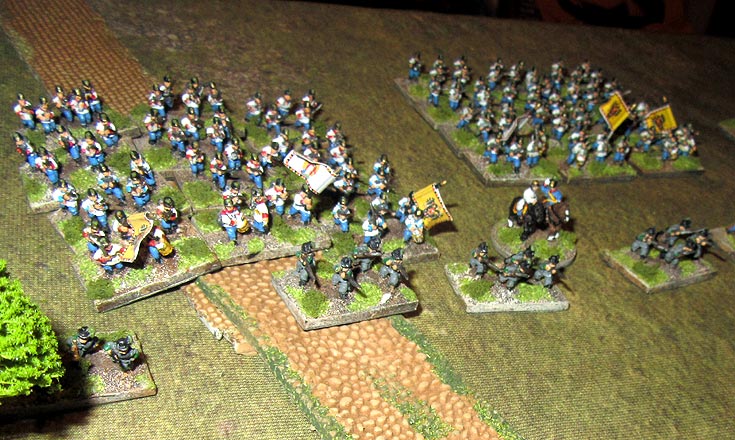
The Clash at Knischnitz,1866
26th October 2023, 0 Comments
Bismarck’s Wars, Fire & Fury, 10mm
We were stuck again. Yet another “hoolie” was blowing, and the Churchill Barriers were closed. So, with a game at the club off the cards, Sean 2 came round for a game in my kitchen instead. As it was so windy we didn’t bother bringing in the 6×4 table from the garage. So, we played on my 6×3 foot dining table – instead! because of this, we opted for 10mm, as it didn’t need quite so much space. 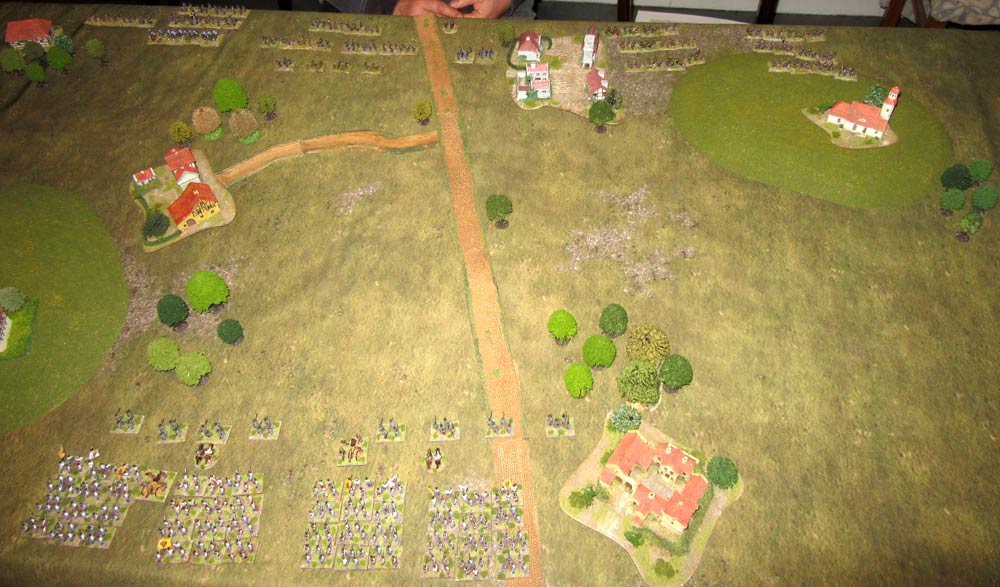 We opted for the Austro-Prussian War of 1866 – a small game, with both sides having the equivalent of a division a side. For the Prussians, that actually was a division – general Trümping’s 5th Division, part of the Prussian First Army. For the Austrians, with their strange organisation, the Prussians were faced by two brigades, led by generals Poschacher and Leiningen. of the Austrian I Corps.
We opted for the Austro-Prussian War of 1866 – a small game, with both sides having the equivalent of a division a side. For the Prussians, that actually was a division – general Trümping’s 5th Division, part of the Prussian First Army. For the Austrians, with their strange organisation, the Prussians were faced by two brigades, led by generals Poschacher and Leiningen. of the Austrian I Corps.  In Fire & Fury – or rather its Furia Francese European amendments (available online), an Austrain brigade is amde up of two regiments, each of 12 stands, plus a gun battery (a single gun model) and a four stand battalion of Jaegers. that’s the two brigades up above.
In Fire & Fury – or rather its Furia Francese European amendments (available online), an Austrain brigade is amde up of two regiments, each of 12 stands, plus a gun battery (a single gun model) and a four stand battalion of Jaegers. that’s the two brigades up above. 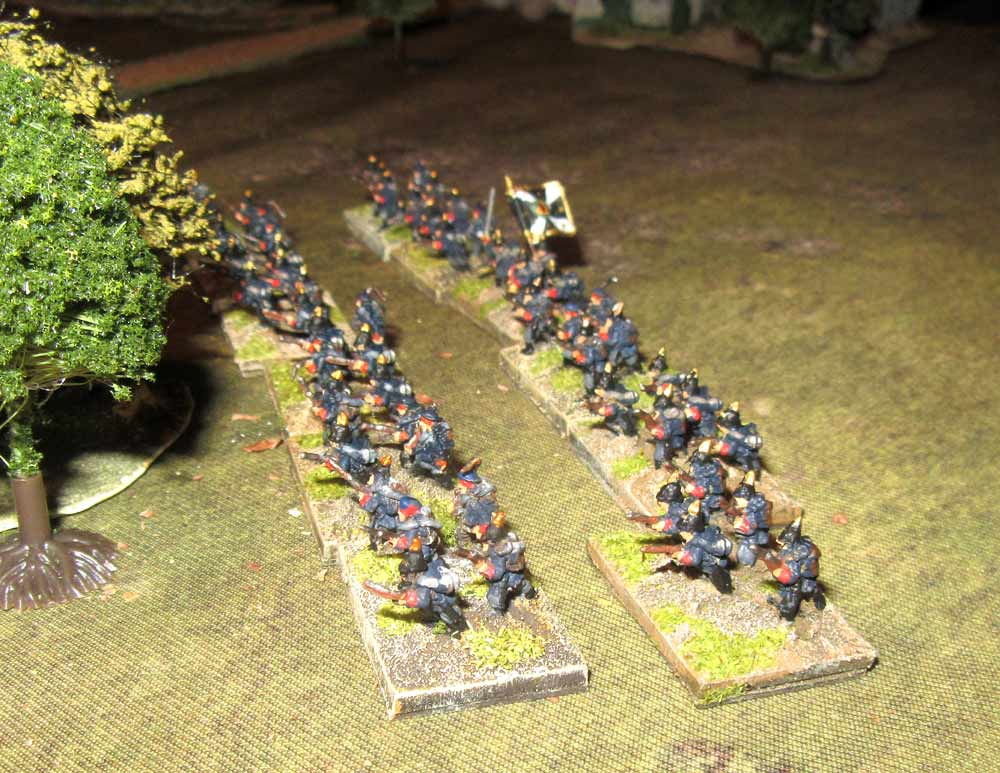 For the Prussians, a Division has four regiments, each of 12 stands, plus a pair of gun batteries – each of one model. Also attached is a four stand jaeger battalion and a four stand dragoon brigade – the two regiments usually attached to the corps. So – a fairly evenly-matched battle, give or take. In this, both sides were advancing into contact, from opposite sides of the table.
For the Prussians, a Division has four regiments, each of 12 stands, plus a pair of gun batteries – each of one model. Also attached is a four stand jaeger battalion and a four stand dragoon brigade – the two regiments usually attached to the corps. So – a fairly evenly-matched battle, give or take. In this, both sides were advancing into contact, from opposite sides of the table. 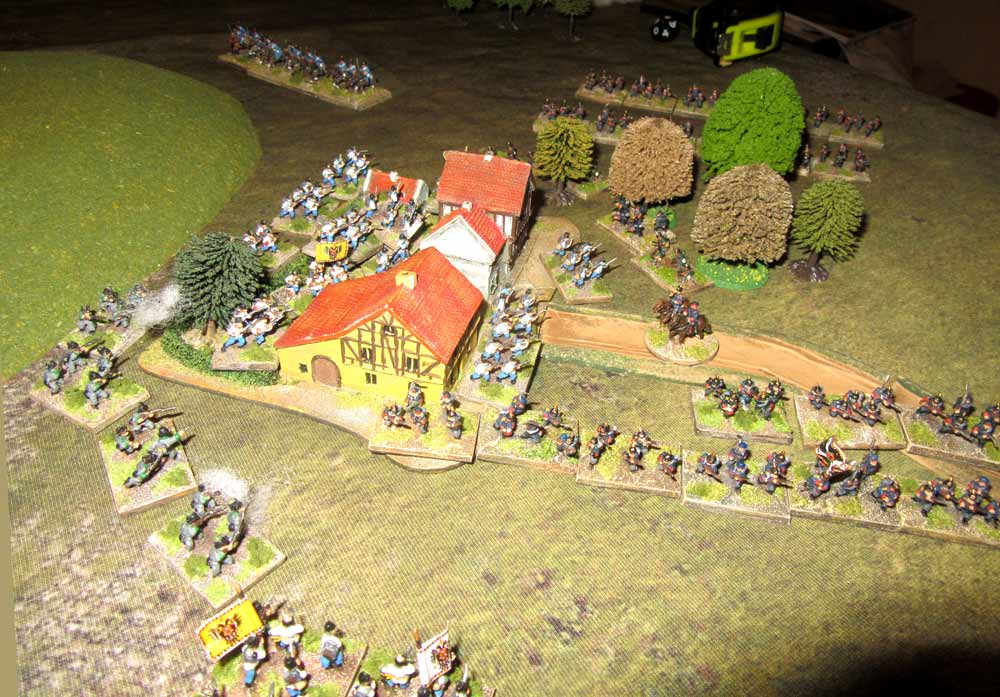 For me, the main aim was to get into the village of Knischnitz, and to concentrate against the Prussian right flank, before the enemy could amass their whole force. My Austrians were slightly limited by their tactical doctrine – it was harder to activate if they weren’t in the regimental-sized column they usually fought in during this war. Still, this was okay, as I planned to use them as a steamroller.
For me, the main aim was to get into the village of Knischnitz, and to concentrate against the Prussian right flank, before the enemy could amass their whole force. My Austrians were slightly limited by their tactical doctrine – it was harder to activate if they weren’t in the regimental-sized column they usually fought in during this war. Still, this was okay, as I planned to use them as a steamroller. 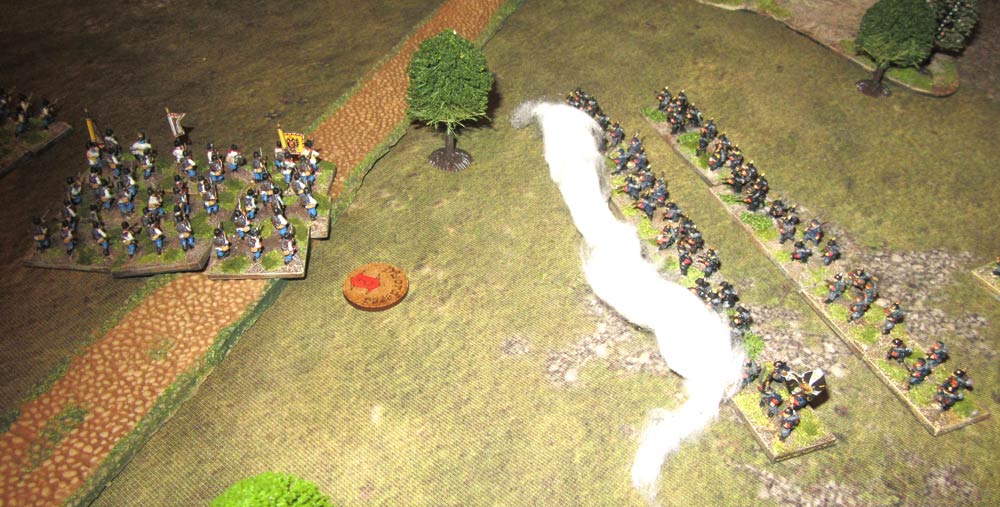 This worked, up to a point. I managed to drive into the village with a regiment of Poschacher’s Brigade, supported by the rest of my force, but then a regiment of Leiningen’s (the 38th) got hauled by the Prussian guns, and then shot in the flank by the Prussian 8th Leib Grenadier regiment. They held their ground, but they took heavy casualties. So – sort of mixed results so far!
This worked, up to a point. I managed to drive into the village with a regiment of Poschacher’s Brigade, supported by the rest of my force, but then a regiment of Leiningen’s (the 38th) got hauled by the Prussian guns, and then shot in the flank by the Prussian 8th Leib Grenadier regiment. They held their ground, but they took heavy casualties. So – sort of mixed results so far!  In the village, my 30th regiment held the place, despite heavy fire from the Prussian jaegers, and the 18th regiment, which was deployed to the east of the village, in the centre of the table. The Prussians though took a pounding from the Austrian jaegers and the guns, which had moved dangerously far forward, and by the flanking fire from the village.
In the village, my 30th regiment held the place, despite heavy fire from the Prussian jaegers, and the 18th regiment, which was deployed to the east of the village, in the centre of the table. The Prussians though took a pounding from the Austrian jaegers and the guns, which had moved dangerously far forward, and by the flanking fire from the village.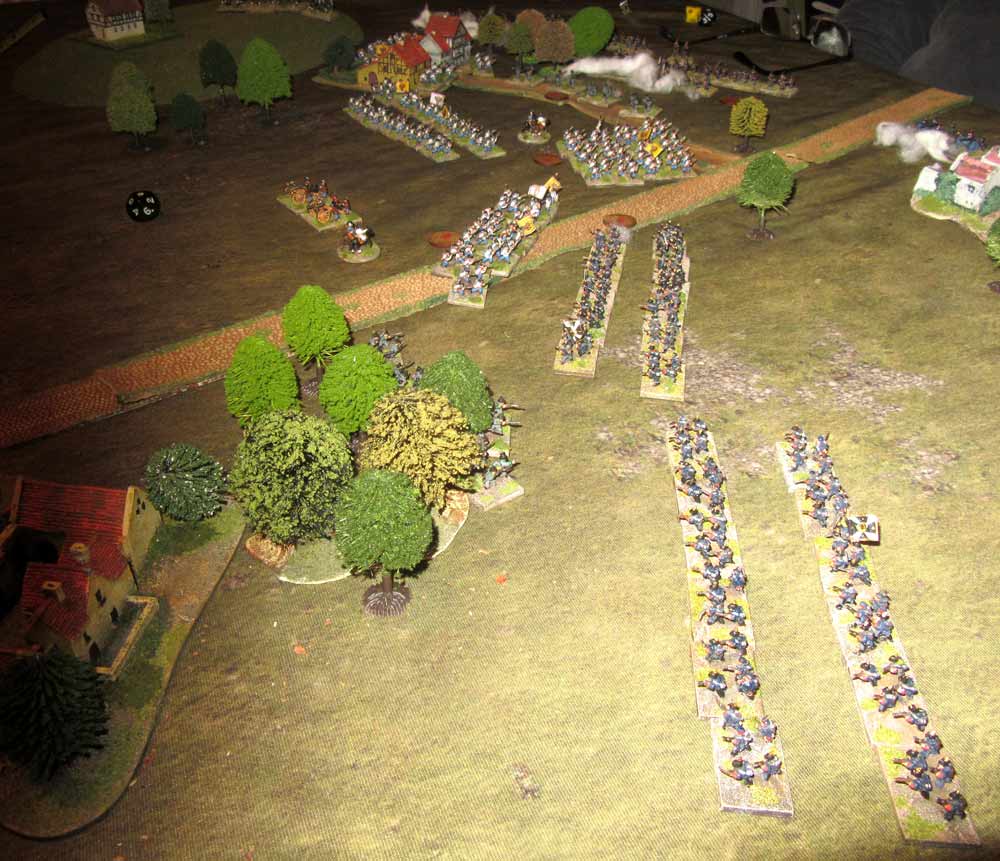 So, when the Austrian 33rd regiment charged in, the demoralised Prussians pulled back. I should have felt pleased by this, but trouble was brewing on the Austrian left, as the two regiments of Sean’s 9th Brigade had now advanced like a closing door, threatening my right flank, and my rear, near the little village of Glinolitz – the one on the bottom left of the picture above.
So, when the Austrian 33rd regiment charged in, the demoralised Prussians pulled back. I should have felt pleased by this, but trouble was brewing on the Austrian left, as the two regiments of Sean’s 9th Brigade had now advanced like a closing door, threatening my right flank, and my rear, near the little village of Glinolitz – the one on the bottom left of the picture above. 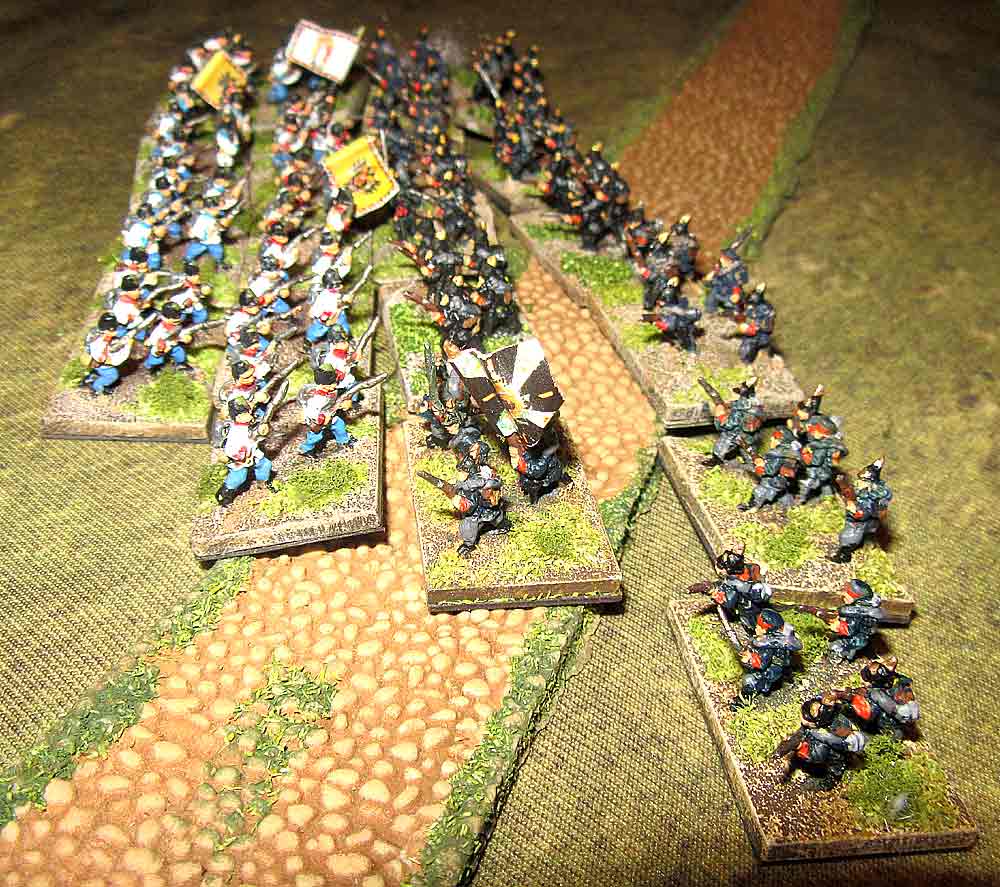 This was Sean’s big chance. His Leib Grenadiers charged into the flank of my battered 38th regiment, but surprisingly they held their ground for a bit, before retiring to the west. That was bad – the Prussians might well roll up my flank and rear. however, things were going on in the centre too. So far the Prussian 10th Brigade had failed to drive the Austrians out of Knischnitz using firepower.
This was Sean’s big chance. His Leib Grenadiers charged into the flank of my battered 38th regiment, but surprisingly they held their ground for a bit, before retiring to the west. That was bad – the Prussians might well roll up my flank and rear. however, things were going on in the centre too. So far the Prussian 10th Brigade had failed to drive the Austrians out of Knischnitz using firepower. 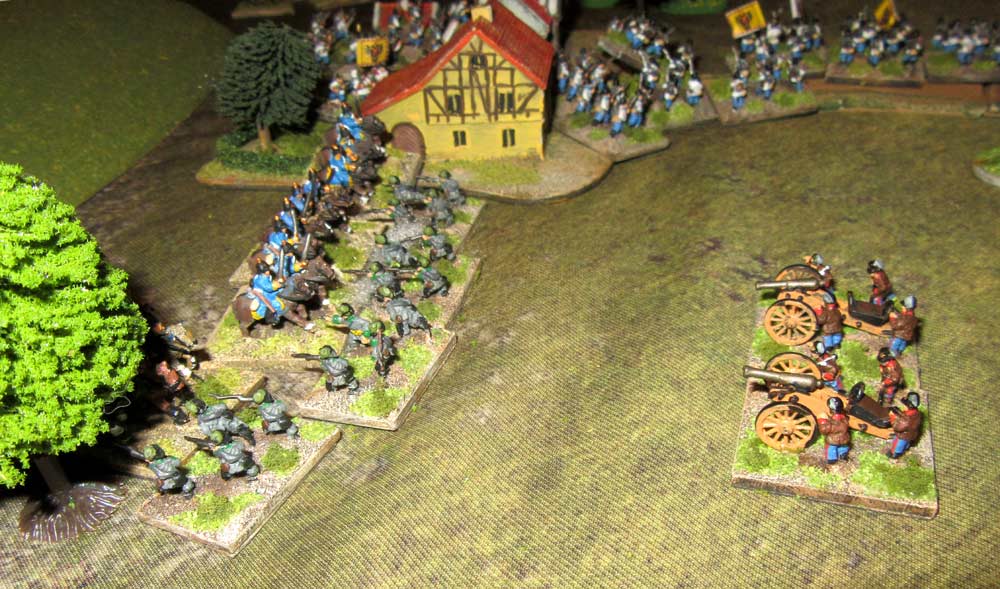 Sean decided to try it with cold steel, but perhaps sensibly his now depleted Prussian 18th regiment retired instead. This wasn’t good for the Prussian dragoons, which had chosen that moment to charge the Austrian 18th Jaegers. The lights held their ground though, giving me the time to turn my guns to face this new threat. The cavalry were stopped for now, , but they were still there, lurking.
Sean decided to try it with cold steel, but perhaps sensibly his now depleted Prussian 18th regiment retired instead. This wasn’t good for the Prussian dragoons, which had chosen that moment to charge the Austrian 18th Jaegers. The lights held their ground though, giving me the time to turn my guns to face this new threat. The cavalry were stopped for now, , but they were still there, lurking.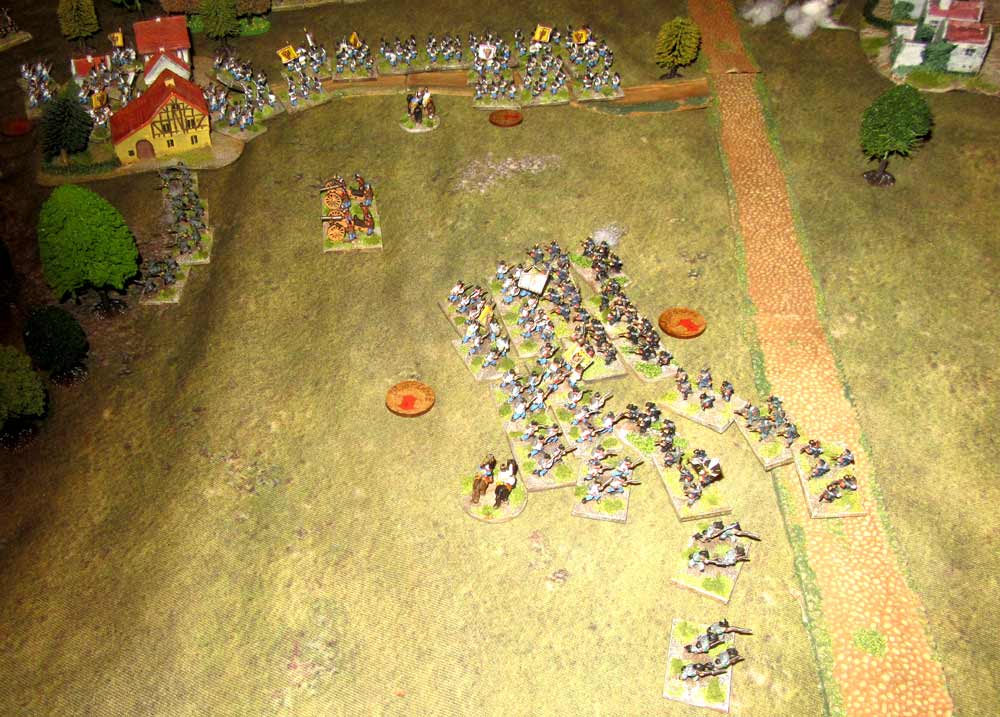 We were now both in fairly bad shape, with both sides having lost about 25% casualties. So, when the Prussian 9th Brigade – the closing door guys – decided to pull back, we decided to end the game. Essentially, both sides were in no real shape to continue. We declared the game a draw, but I was just happy that for once, my Austrian attack columns had actually their job … and survived!
We were now both in fairly bad shape, with both sides having lost about 25% casualties. So, when the Prussian 9th Brigade – the closing door guys – decided to pull back, we decided to end the game. Essentially, both sides were in no real shape to continue. We declared the game a draw, but I was just happy that for once, my Austrian attack columns had actually their job … and survived! 




